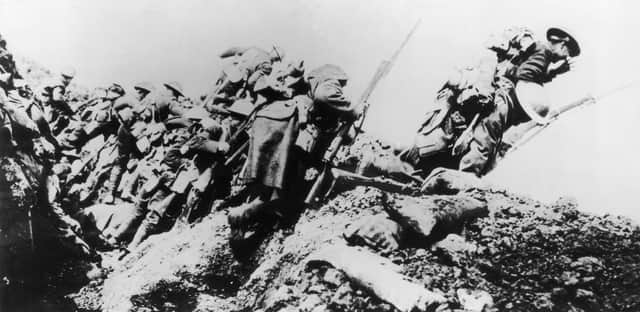The Battle of the Somme: How the Manchester Pals joined thousands in going over the top
and live on Freeview channel 276
The Battle of the Somme is a chapter of the First World War which, for many, defines the conflict. It is the epitome of the waste of life which the war has become known to be, and the Somme was the peak of the insanity which fuelled the years of slaughter.
The first day of the battle, July 1, remains the darkest day in the history of the British Army. The task for the allies was to relieve German pressure on the French town of Verdun and spread German forces thinner.
Advertisement
Hide AdAdvertisement
Hide AdThe mainly British and Commonwealth force which would advance on the Somme looked on for a week as artillery bombarded the German lines day and night. It was expected that there would be little resistance and then defences would be breached.
So much so was this the case that in some places, generals told their men to stroll across no-man’s land- they were so sure that nothing would be waiting for them. Sadly, this wasn’t the case.
In other cases, the weight of the soldiers equipment and the heat of the morning prevented troops from advancing quickly. Both outcomes had devastating consequences.
The first attack began at 7.30am and thousands of soldiers climbed over the top and started across no man’s land. In some places, machine gun fire started almost instantly and soldiers began to fall across the frontline.
Advertisement
Hide AdAdvertisement
Hide AdMany of the soldiers who were involved in the attack belonged to Pals Battalions. At the start of the war, Britain was without a large scale army, instead having a small professional British Expeditionary Force (BEF). When it soon became apparent that conscription would be needed to boost the numbers, a plan was hatched to encourage men to join up and fight alongside friends and family from back home.
Thousands of men rushed to join up and these ‘pals battalions’ were set up in towns and cities across the country. One of the first was set up right here in Manchester.
Origins of the Manchester Pals Battalion
By 1914, 10,000 men from Manchester had signed up to join the pals battalion. Sir Daniel McCabe, the Lord Mayor of Manchester, called for the creation of a battalion made up of local workers.
Men from many different industries and backgrounds answered the call. They formed a large number of the wider Manchester Regiment and were trained up ready for combat.
Advertisement
Hide AdAdvertisement
Hide AdThe Manchester Pals, like with many other Pals battalions, would have their first real taste of war on the Somme. The hope from British Army generals was that men fighting alongside friends and family would increase morale- the reality was, however, far less positive.
Almost entire work forces and community groups were wiped out as the German machine gun fire began. Friends, brothers and cousins died side by side. There were eight Manchester Pals groups that were amalgamated into the Manchester Regiment.
Manchester Regiment role on July 1 1916
The battalions of the Manchester Regiment had various objectives across the frontline on July 1. The 16th, 17th and 18th battalions were tasked with capturing Montauban, which they did. This was seen as one of the few successes of the day, but over 170 soldiers from the 18th were lost in the advance.
Was the Battle of the Somme a success for the British?


The first day was the bloodiest, with both sides suffering tens and thousands of casualties for little to no advantage. Yet the battle was far from done and would rage on for another four months, leading to the deaths of thousands more soldiers.
Advertisement
Hide AdAdvertisement
Hide AdWhen it did eventually grind to a halt in the winter of 1916, over one million men had become casualties. In 141 days, the British had advanced just five miles. 120,000 Allied troops—including those from Australia, India, South Africa, New Zealand, Newfoundland and Canada- took part in the first day of the battle. Almost half had been killed or wounded at the end of the day. It is estimated that one soldier was killed every 4.4 seconds on the first day- making it the bloodiest day in the history of the British Army.
British Commander-in-Chief Sir Douglas Haig brought the Allied campaign on the Somme to an end on November 18 1916. The main objective of the Battle of the Somme was to relieve the French at Verdun, and after the battle game to an end Haig gave his thoughts on it.
He said: “Verdun had been relieved; the main German forces had been held on the Western front; and the enemy’s strength had been very considerably worn down. Any one of these three results is in itself sufficient to justify the Somme battle.”
The battle was seen as controversial, and Haig was heavily criticised for leading so many Allied soldiers into what many people saw as a wholesale slaughter. Whatever your thoughts on the battle, it must be said that the battle was a terrible waste of life for both sides.
For more information on the Manchester Pals and the Manchester Regiment, visit the 17th Manchester's web page.
Comment Guidelines
National World encourages reader discussion on our stories. User feedback, insights and back-and-forth exchanges add a rich layer of context to reporting. Please review our Community Guidelines before commenting.
